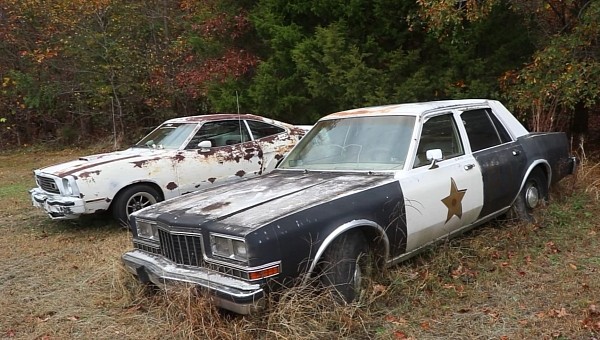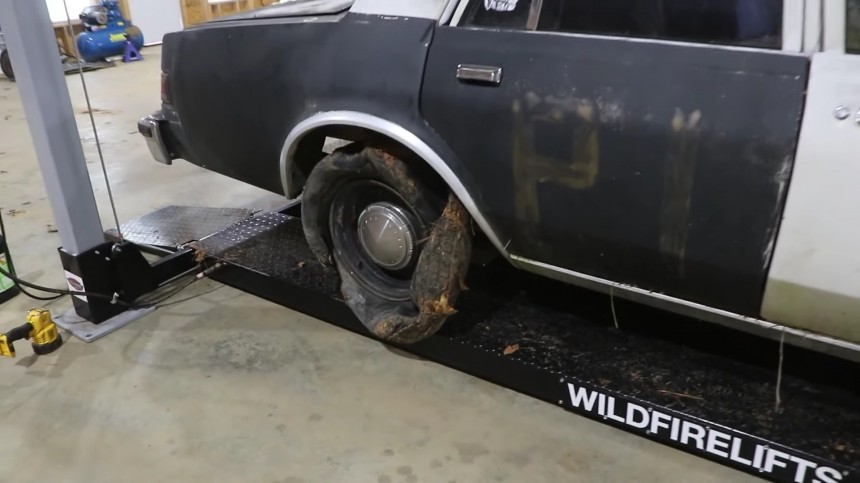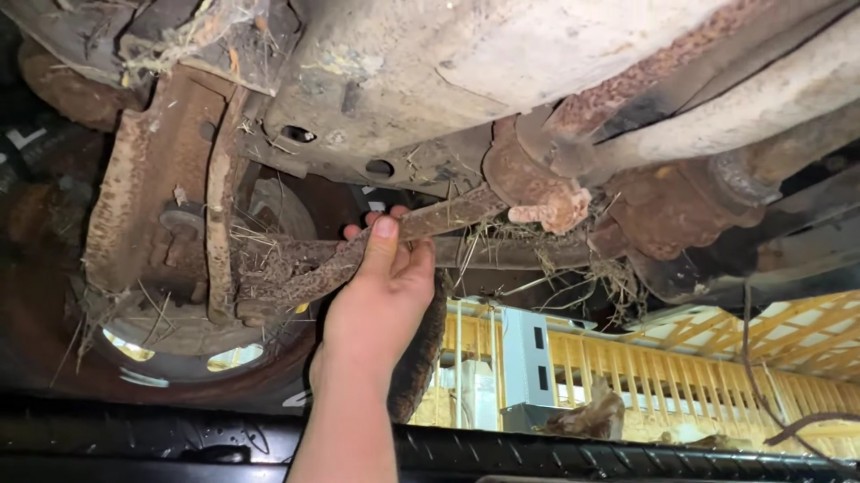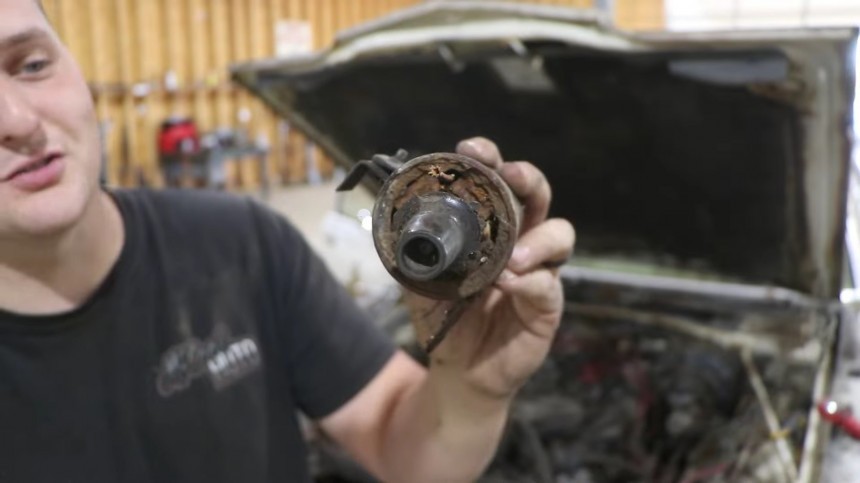The Police Dodge Diplomat rescued by the Mopar enthusiast and YouTuber Dylan McCool is a historic, if somewhat sad, landmark for Chrysler. It was the last rear-wheel sedan of the corporation from 1989 until 2005. It also sported a computer-controlled carburetor and ignition system. This feature left mixed feelings with its users, particularly the low-performing 2-bbl.
The 1986-built car served with the Boys in Blue from Athens, Georgia, for a while. It saw its retirement sometime in 1997, and then it was forgotten. Still, the factory police package helped the car through its rough life and equally rough post-service period. Despite the two-decade sitting, the Diplomat lives up to its trooper status. The special 318 V8 (5.2 liters) runs again, with some help from the YouTuber.
Because he is a dedicated fan of special vehicles, Dylan will restore the Dodge. He will need to rub some elbow grease on this rusty Mopar to get it into a better shape. However, the significant bit about the project – the powertrain – works acceptably well (the car drives forward, but reverse poses some problems). Still, the "door open" alarm works, and the vent for the air conditioning blows like new (check the video to learn more about what runs and what doesn't).
After all, the engine Chrysler installed under the hood of these particular vehicles is a 318 V8 with many modifications. The Force preferred the four-barrel carburetor to get the best out of the mill. As a result, the cylinder heads and intake were from a 360 CID engine (5.9-liter). Technically, the heads had a “318 Pursuit” casting on them to differentiate from the civilian version.
Bottom line – the engine on the police cars came in two variants: either with the two-barrel carb or the bigger, more powerful four-barrel. It made a lot of difference – remember, this Dodge saw action in the mid-to-late-80s and early 90s. The base Police variant offered 120 hp and 240 lb-ft of torque (325 Nm). The bigger carburetor gave the Diplomat extra authority (175 hp and 250 lb-ft/339 Nm).
Regardless of its output, the engine wore a “heavy-duty” badge, which meant a larger radiator and alternator. However, it also had some flaws – one would be the electronically-controlled carburetor. One of Dylan’s followers (a former police officer who used one Dodge Diplomat) very plastically describes the double-barrel: “These were the absolute worst police cars during my career. 318 2bbl would buck and stall and couldn’t get out of its way. We were so relieved when they replaced them with Crown Vics.”
On the other hand, the 4-bbl was a different story altogether – and the video proves this. The potent mill came with roller cams and twin timing chains. Everything about this police-special 318 CID (5.2-liter) V8 was heavy-duty: the exhaust manifolds and the special-alloy hypereutectic pistons, which allowed for a lower piston-to-jacket clearance.
These aluminum pistons were cast using a particular ratio between the compounding elements (silicone and aluminum). This gave the metal better heat stress resistance. The significant advantage is that the piston doesn’t expand as much under temperature variations, so the casting tolerances are reduced compared to regular alloys.
The list continues with chrome-plated oil rings, forged steel connecting rods, heavy-duty valve springs, and high-strength rocker arms. High-temp valve seals, shields, heads cover gaskets, a lubrite-treated camshaft, and nimonic-coasted exhaust valves are included, too. Finally, the kolene-cleaned cylinder heads, high-temp-resistant steel intake valves, and a heavy-duty water pump gave the 318 Pursuit extreme endurance.
Setting aside the relatively arid metallurgical details, the police Diplomats were sturdy cars overall. Their rugged engines and transmissions performed well under heavy loads. The vehicle Dylan dug out would have run the 0-60 mph (0-97 kph) in 10.9 seconds. Holding the accelerator to the floor gave the car a maximum speed of 121 mph (195 kph) – close to the speedometer limit of 125 mph (201 kph). The police cars had a “Certified” speed dial that accurately read both mph and kph.
For the sake of performance, we’ll drop the 0-100 mph (0-160 kph) time – 34 seconds – and the quarter-mile sprint - 18.2 seconds. However, there’s more about the Blues Diplomat than what’s under the hood. Stiffer suspensions, more rigid sway bars (front and rear), and cast-iron K-member bushings (the standard cars had rubber ones) made the Dodge Diplomat into the server and protector.
The much-improved handling thus obtained came at the cost of the stiff ride. Then again, the police officers weren’t looking for smoothness over high-speed stability. Dodge knew how the police cars came to be used; as such, some of the Diplomats had the first gear locked out. Since the cars only had the automatic three-speed transmission, manual shifting from second to first gear was prevented. That way, the trooper behind the wheel would not rev the engine into the stratosphere by brutally downshifting (either to accelerate faster or to bring the car to a halt after a high-speed pursuit).
However, because terminal velocities needed to be greater than civilian market cars, the Diplomatic Dodges received 8-1/4″ differentials with Sure-Grip and 2.94:1 ratio. The rear axles on police cars were straight rods to handle the mechanical stresses. The general public got the lighter-duty axle tubes that narrowed in diameter closer to the differential.
You noticed that Dylan had to replace all four wheels on the Dodge. The police cars had performance tires installed - the usual choice was the wider Goodyear F32 P215/70 R15 rubbers. Also, sizeable 11-inch drum brakes were standard on special vehicles (such as police and taxi Diplomats).
Because he is a dedicated fan of special vehicles, Dylan will restore the Dodge. He will need to rub some elbow grease on this rusty Mopar to get it into a better shape. However, the significant bit about the project – the powertrain – works acceptably well (the car drives forward, but reverse poses some problems). Still, the "door open" alarm works, and the vent for the air conditioning blows like new (check the video to learn more about what runs and what doesn't).
After all, the engine Chrysler installed under the hood of these particular vehicles is a 318 V8 with many modifications. The Force preferred the four-barrel carburetor to get the best out of the mill. As a result, the cylinder heads and intake were from a 360 CID engine (5.9-liter). Technically, the heads had a “318 Pursuit” casting on them to differentiate from the civilian version.
Bottom line – the engine on the police cars came in two variants: either with the two-barrel carb or the bigger, more powerful four-barrel. It made a lot of difference – remember, this Dodge saw action in the mid-to-late-80s and early 90s. The base Police variant offered 120 hp and 240 lb-ft of torque (325 Nm). The bigger carburetor gave the Diplomat extra authority (175 hp and 250 lb-ft/339 Nm).
On the other hand, the 4-bbl was a different story altogether – and the video proves this. The potent mill came with roller cams and twin timing chains. Everything about this police-special 318 CID (5.2-liter) V8 was heavy-duty: the exhaust manifolds and the special-alloy hypereutectic pistons, which allowed for a lower piston-to-jacket clearance.
These aluminum pistons were cast using a particular ratio between the compounding elements (silicone and aluminum). This gave the metal better heat stress resistance. The significant advantage is that the piston doesn’t expand as much under temperature variations, so the casting tolerances are reduced compared to regular alloys.
The list continues with chrome-plated oil rings, forged steel connecting rods, heavy-duty valve springs, and high-strength rocker arms. High-temp valve seals, shields, heads cover gaskets, a lubrite-treated camshaft, and nimonic-coasted exhaust valves are included, too. Finally, the kolene-cleaned cylinder heads, high-temp-resistant steel intake valves, and a heavy-duty water pump gave the 318 Pursuit extreme endurance.
For the sake of performance, we’ll drop the 0-100 mph (0-160 kph) time – 34 seconds – and the quarter-mile sprint - 18.2 seconds. However, there’s more about the Blues Diplomat than what’s under the hood. Stiffer suspensions, more rigid sway bars (front and rear), and cast-iron K-member bushings (the standard cars had rubber ones) made the Dodge Diplomat into the server and protector.
The much-improved handling thus obtained came at the cost of the stiff ride. Then again, the police officers weren’t looking for smoothness over high-speed stability. Dodge knew how the police cars came to be used; as such, some of the Diplomats had the first gear locked out. Since the cars only had the automatic three-speed transmission, manual shifting from second to first gear was prevented. That way, the trooper behind the wheel would not rev the engine into the stratosphere by brutally downshifting (either to accelerate faster or to bring the car to a halt after a high-speed pursuit).
You noticed that Dylan had to replace all four wheels on the Dodge. The police cars had performance tires installed - the usual choice was the wider Goodyear F32 P215/70 R15 rubbers. Also, sizeable 11-inch drum brakes were standard on special vehicles (such as police and taxi Diplomats).





































